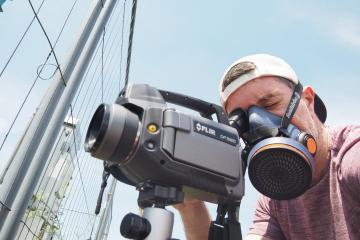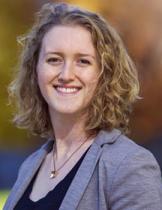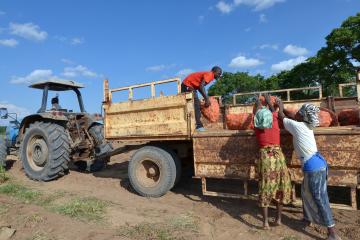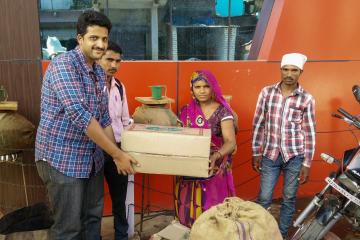
Alumni working together: Abhilasha Purwar ‘15 and Amber Luong ‘15 on the need for disruptive innovation to fight climate change

Amber Luong and Abhilasha Purwar met while working on a J-PAL South Asia research team evaluating a novel emissions trading scheme in India. Abhilasha has since co-founded Blue Sky Analytics, a climate tech startup aiming to make geospatial data accessible to drive environmental impact, and Amber is now head of partnerships at Blue Sky. They joined us to chat about running a randomized evaluation at the intersection of economics and the environment, the experience of launching a start-up, and advice for J-PALers on joining the fight against climate change.
What first inspired you to build a climate-focused career, and how did that lead you to J-PAL?
Amber: I started my career in the financial sector, but as I learned about the urgency of climate change and the scale of transformation required to tackle it, I decided to pivot my career in that direction. I did extensive research on paths I could take, and in the course of that, I became particularly interested in the overlap between environmental challenges and development. After discovering J-PAL and randomized evaluations, I became very attracted to the idea of applying that standard of rigorous measurement to environmental challenges. I found out about Michael Greenstone’s pioneering work in that area in graduate school, so when a position opened up at J-PAL South Asia to manage his emissions trading scheme (ETS) evaluation—the decision to apply was a no-brainer.
Abhilasha: My answer is simply that Amber hired me for the ETS project! I had just finished my engineering degree and was working a very unstimulating job. I wanted learning opportunities and to grow in my career, and knew I’d have to try something different to find that. Despite having zero background in economics, I decided to apply for a research associate (RA) position at J-PAL—I ended up staying for two and a half years!
Abhilasha, you came from a background in the natural sciences—how did this prepare you for life as a J-PAL research associate, and what did you have to learn on the job?
Abhilasha: I was doing science research before J-PAL, which is similar to economics research in that it’s a lot of math, data analysis, critical thinking, asking the right questions, etc. It’s a form of logical thinking that applies across the disciplines and also to the software tech work we do at Blue Sky Analytics. The ETS project RAs were the only team of engineers at J-PAL, which made us the odd ones out, but it was a great experience both for us and the other RAs to be around people from different backgrounds. I also loved how gender-balanced the office was, especially having come from an engineering background that is very male-skewed.
Amber, could you tell us about the Emissions Trading Scheme evaluation you both worked on, and your responsibilities within it?
Amber: The idea behind the project was to implement and evaluate a new mechanism for regulating industrial particulate pollution in India. The ETS project was quite ambitious even by J-PAL standards—it involved a very close partnership with the Indian Government, including the Ministry of Environment, Forest, and Climate Change, and Pollution Control Boards at the Central and State levels.
The high-level idea was to introduce a form of cap and trade for particulate pollution in industrial clusters in India and evaluate its impact on measures like industry compliance, mitigation costs etc. But to enable that form of regulation first required introducing technology for monitoring pollution continuously at the factory level (known as CEMS). A critical step in the project was collaborating with the government on creating technical standards for the monitoring equipment, which would enable the rollout of the equipment in the pilot industries for the study. During my time on the project we also launched the baseline survey, so those two major activities were central to my time at J-PAL. My role was a combination of government relations, coordination with the primary investigators and J-PAL management, and overseeing the RAs in the field.
Amber, you worked with a technically diverse group on this project, including a team of engineers, academic economists, and stakeholders in government and the private sector. What did you learn from liaising across these groups, and what helped you do so successfully?
Amber: As a non-engineer, I found the technical learning curve of the project really daunting at first, and I wondered how I could even contribute meaningfully. But each milestone of the project required getting the buy-in of many parties, including government and industry representatives, who were often learning about CEMS and ETS for the first time, so it turned out that listening skills and clear communication mattered as much as the technical details. It is remarkable how much trust you can build by genuinely listening to and acknowledging your partners’ views—too many people equate communication skills with speaking skills, but that only covers one direction! When your speaking is informed by what you learn by listening, it can be game changing.
Abhilasha: Listening and condensing information is one of Amber’s superpowers, not to mention patience! This is very important when it comes to climate change, where you have to navigate so many people and so many opinions and so much jargon to get concrete actions done.
Abhilasha, are there any memorable moments from your time as an RA that influenced your path?
Abhilasha: Absolutely, I was 22 years old, in my first job, and very impatient. I was meeting with all these government officers who operated at a very slow pace, and had to learn to adjust to their speed. I’ve gained so much patience since, and this skill has been really helpful later in life.
I managed the Gujarat part of the baseline survey, which was about 300 factories, and I trained around 200 people to use the monitoring equipment. I was also often the only woman around for days at a time when I was out doing fieldwork. The environment around these factories was extreme—dirt and smoke and trucks, orange rivers, just no signs of humanity. I ended up cutting my hair off because the constant dirt was so bad! It made me question the whole approach to industrialization, which was fascinating to me as an engineer. It made me a more responsible scientist.

Abhilasha, you made the leap in 2018 to launch your own company, Blue Sky Analytics. What inspired you to found it, and what does Blue Sky aim to do?
Abhilasha: I had the chance to meet Esther and Abhijit early on in my J-PAL career and had a really transformative conversation with them about founding J-PAL. Being a CEO means taking your dream and installing it in everyone's head, getting them to make it their own dream too—that’s how organizations grow. These two people had a remarkable thought, and now hundreds of us at J-PAL do, too. This was a great starting point for me to become an entrepreneur later in life.
Working at J-PAL SA also made me more fearless, and exposed me to what it was like to work at an early-stage organization. My incredibly accomplished colleagues inspired me to go on to get a graduate degree in environmental management from Yale, and this in turn enabled me to later start my own company.
Becoming an entrepreneur is famously challenging—what has surprised you about the process of growing your company, and what were some of the obstacles you faced?
Abhilasha: We’ve never stopped running into obstacles! But the first thing we had to do was just jump off the cliff—99 percent of people aren’t entrepreneurs because they just don’t make the leap. I had my brother as a co-founder, and doing it together with him made the decision a little bit easier.
The challenges are constantly evolving, so I think what you learn as an entrepreneur is, more than solving one particular challenge, is just the art of solving the challenges. Over time you get a little bit more optimistic about your capabilities, and you'll know that you'll get to the other side. Learning to have fun and overcome the fear of failure also helps.
What do you see as today’s key opportunities in the fight against climate change, both for climate tech entrepreneurs like yourselves and for those engaged in research and policy change?
Amber: The latest buzzword in the climate tech space is “climate intelligence.” And like all new buzzwords, there are varying definitions floating around, but broadly I think of it as all of the different ways we can harness data to better understand how human activities, assets and infrastructure are (a) contributing to climate change and (b) impacted by climate change. This information has been produced at a more macro level for decades by the scientific community, but the difference now is the focus on understanding these impacts at a very granular level in order to inform mitigation and adaptation activities by the responsible companies, government bodies, individuals, etc.
It is critical to have timely, granular climate data because beyond outright greenwashing, there is a real risk of spending massive amounts of money and time on either ineffective or even (unintentionally) harmful activities under the auspices of climate action. Addressing what I feel is still our very superficial level of understanding in this area will require action (and ideally, a level of partnership and coordination) across all of the groups you mentioned.
Abhilasha: It's clear to me that the way we live our lives isn't sustainable. We're currently producing 55 billion tons of carbon emissions, and if we were taking any meaningful climate action, this would be decreasing year-by-year. Instead, this number is still increasing. What we lack right now is imagination; we need to do things differently—rather than incremental improvements, we need disruptive innovation.
Blue Sky Analytics is designed to foster disruptive innovation through making climate data available to everyone, like how Google helped democratize access to information years ago. The challenge is that there is a lot of inertia right now; it’s difficult to get smart people to work on new disruptive, imaginative work. Amber and I decided to leave behind the traditional path, and so can you—we hope more people join us!
What recommendations do you have for J-PALers and members of the evidence-to-policy community more broadly who would like to get involved?
Abhilasha: J-PALers are one of the smartest bunch of people who all have a very burning desire to do something other than for themselves and a sense of responsibility towards the world at large, but not enough of us take the plunge and try something radically different from the traditional development path. You have the brains and the talent to do it—so go out and make an impact.
Amber: If you want to get involved in the fight against climate change but stay within the J-PAL/IPA sphere, I am really encouraged to see growing numbers of evaluations of climate adaptation measures within vulnerable communities and other environment-focused projects. But even outside of the evaluation community, I see a real need for that same level of rigor in measuring impact, especially with the rising focus on measuring corporate sustainability (the organization Y Analytics comes to mind as an example).
Abhilasha: I would also caution J-PALers as economists to think about the environment as a system, because solving one problem can sometimes lead to ten new problems—everything is connected.
Amber: To that point, it’s also crucial to understand how human behavior intersects with climate change impacts, and in some cases, amplifies them—like the example of climate change-induced drought patterns coupled with overconsumption of water resources. Your time at J-PAL will have given you tools for understanding behavioral responses to policy interventions, but it is critical to also bolster your understanding of the dynamics of natural systems as well. We increasingly need to break down barriers between disciplines to really tackle these challenges effectively.
How has your time at J-PAL had an impact on your work at Blue Sky Analytics, if at all?
Amber: It's had a huge impact in two main ways. Blue Sky’s work is at the intersection of space tech and climate tech, with potential customers who could be insurance companies, financial institutions, government bodies, or researchers, among others. So it is again a similar mix of bringing new technology and new data sources to potential users who might not be familiar with their capabilities. This means we need to provide accessible explanations of our current data offerings but also listen carefully to customer needs and shape our product offerings accordingly.
My time at J-PAL has also shaped the way that I think about measuring impact, in a way that has not yet been widely embraced in the broader sustainability sector. As I alluded to earlier, I think there is a huge scope for advancing how we measure and understand the intersection of human activity and environmental impacts, and I want the datasets we create at Blue Sky Analytics to transform that understanding in actionable ways.
Learn more about Blue Sky Analytics.


